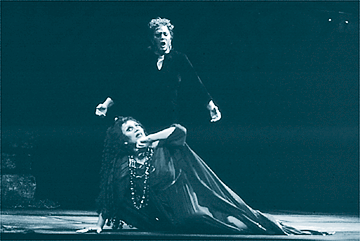


HOT sacrifices nothing
for electrifying ‘Elektra’Elektra: Presented by Hawaii Opera Theatre, Blaisell Concert Hall. Repeats at 7:30 p.m. tomorrow. Tickets $23-$77. Call 596-7858.
By Ruth O. Bingham
Special to the Star-BulletinHAWAII Opera Theatre assembled an outstanding cast for its production of Richard Strauss' "Elektra," a difficult work for any opera house.
Friday's performance verified that "Elektra," never before performed in Hawaii, lies on the fringes but is still within HOT's capabilities. It was a performance no one will soon forget.
Based on a Classical Greek tale, "Elektra" is a gripping, emotionally exhausting opera in which every word and note is laden with significance. In retrospect, it is easy to forget that the opera has sections of great beauty as well. HOT performs it without intermission so that its not-quite-two hours blaze past like a brush fire.
Elektra's father, King Agamemnon, sacrificed Elektra's elder sister to the gods to win the Trojan War. When he returns victorious, his wife Klytämnestra and her lover Aegistheus murder him and claim the throne. Their insecure rule is bathed in the blood of sacrifice. Unable to sacrifice her children, Klytämnestra pays to have her son Orestes murdered far away and banishes her headstrong daughter Elektra, but allows her weaker daughter Chrysothemis to wander the court in limbo.
Unbowed, Elektra survives on fantasies of revenge, plotting ways to kill her mother and Aegistheus. When Chrysothemis can't bring herself to help murder their mother, Elektra curses her and thereby herself as well. Orestes returns in disguise and with Elektra's urging, murders Klytämnestra and Aegistheus. In celebration, cursed Elektra dies as Orestes cowers before the vengeful Furies. Thus ends the house of Agamemnon.
Director Henry Akina cast the three female leads beautifully: belying the singers' actual ages, their voices firmly established their characters and relationships.
Dramatic soprano Janis Martin (Elektra) possesses a magnificent heroic instrument that easily filled the hall, even over the large orchestra. Although age has begun to nibble at the upper edges of her considerable range, she has a strong, clear voice and a superb clarion quality in her upper middle range: her cry of recognition, "Orestes!" raised goose bumps. Martin is an excellent actress as well. She even dies well.
Mezzo-soprano Ruthild Engert presented a wonderfully dark-voiced, conflicted, complex Klytämnestra. Also an excellent actress, Engert was a delight every moment she was on stage. Her rich voice made her description of nightmares truly horrifying, and her hysterical, witchy laugh as she exited amid smoking torches was operatic theater at its best.
Maria Russo's voice, like her character Chrysothemis, was caught between Martin's Elektra and Engert's Klytämnestra: darker than Martin's but lighter than Engert's, and neither as strong nor as striking as both. Still, Russo possesses an excellent voice with the high-range edge of a dramatic soprano. That she could be outshone reveals much about the caliber of the cast.
"Elektra" is a woman's opera: the men only show up to kill or be killed. Bass-baritone Charles Austin, with his deep, rich voice, suited his role of Orestes physically as well as musically; and tenor Quade Winter presented an admirable Aegistheus.
Local cast members unfortunately suffered in comparison to the exceptional leads. Although most performed well, a few were clearly in over their heads.
Almost everything about HOT's production deserves praise. Peter Dean Beck's stage design of a crooked, skewered house combining wood and stone set the drama earlier than Classical Greece and captured Agamemnon's crumbling legacy in still life.
Beck's lighting was a high point. He echoed the tale in light: flaring, pulsing, waning the sacrificial and murderous red light of Agamemnon's line; announcing Orestes' return with a shaft of clear light through the gateway; shading the backdrop and sacrificial stone with shifting moods.
From details of interaction to dance movements lifted from Greek urns, Akina's staging worked well throughout. He wove in the Tau Dance Theatre's sacrificial rite seamlessly and constructed a complex relationship between Elektra and Klytämnestra. One clumsy aspect: silhouettes of singers occasionally waiting motionless behind door jambs, only to burst into action when the doors opened; those silhouettes could have furthered the drama.
The large orchestra, ably led by Ivan Törzs, inevitably overwhelmed the voices at times. That is simply a fact of "Elektra," in part because the orchestra is less a background than an active character.
Overall, HOT's "Elektra" offers impressive proof of their artistic reach. It is not to be missed.
Ruth O. Bingham has a Ph.D. in musicology from
Cornell University and is a free-lance writer.
Click for online
calendars and events.